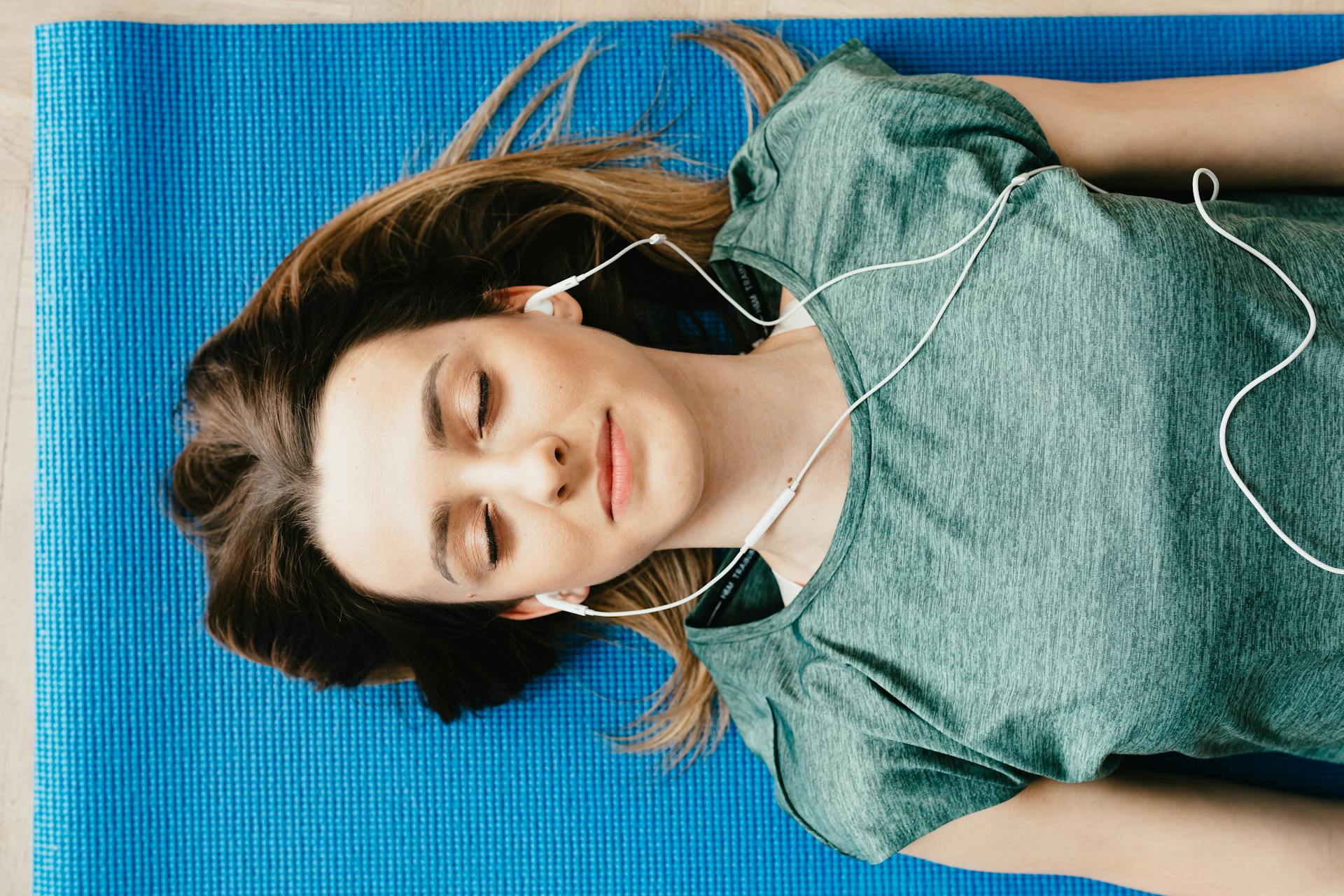If you’ve ever laid in bed with your mind racing, heart pounding, or tension still humming through your body, you’re not alone. Millions of people struggle to fall asleep each night—not because they’re not tired, but because their nervous systems never got the memo that it’s time to rest.
This is where stress relief audio becomes a powerful ally.
Unlike pills or screens, calming audio is a non-invasive, natural, and side-effect-free way to soothe your nervous system and ease into sleep. Whether you’re dealing with anxiety, overthinking, or simply too much stimulation from the day, the right sound can become your personal off-switch.
In this guide, we’ll break down why stress relief audio works, explore the most effective types of audio, and share specific recommendations to help you fall asleep faster and deeper tonight.
Why Stress Relief Audio Helps You Sleep
Falling asleep isn’t just about closing your eyes. It’s about transitioning your brain and body into a different physiological state—one dominated by calm, safety, and surrender.
Unfortunately, stress blocks that transition.
Your fight-or-flight nervous system (sympathetic mode) keeps you alert. But audio designed to promote relaxation taps into your rest-and-digest system (parasympathetic mode), shifting your brainwaves and heart rate into a more sleep-friendly rhythm.
Here’s how calming audio helps:
- Slows breathing and heart rate
- Lowers cortisol levels
- Increases melatonin production
- Encourages delta and theta brainwaves (associated with deep and light sleep)
- Reduces intrusive thoughts by providing gentle focus
It’s like flipping a switch from alert to asleep—without any effort beyond pressing “play.”
1. Nature Sounds: Earth’s Original Lullaby
Nature sounds are among the most effective types of sleep audio, and there’s a reason our brains love them.
From an evolutionary perspective, soft natural environments signal safety. A calm rainforest, ocean tide, or gentle rainfall tells the nervous system: you’re safe—nothing is hunting you—go ahead and rest.
Best Nature Sound Types for Sleep:
🌧 Rainfall
Soft rain on leaves, a tin roof, or windowpanes soothes like white noise but with natural variation. Great for drowning out household or traffic noise.
🌊 Ocean Waves
The rhythmic crash and retreat of waves mimics deep breathing. Ocean sounds have been shown to calm the brain’s default mode network—reducing mental chatter.
🌲 Forest Ambience
Chirping insects, rustling leaves, and distant bird calls create a peaceful “background” that many find meditative.
🔥 Crackling Fire or Wind in Trees
Perfect for fall or winter. These sounds create a cozy, nostalgic atmosphere that promotes feelings of safety and warmth.
2. Binaural Beats: Brainwave Syncing for Sleep
Binaural beats are an audio illusion created when each ear hears a slightly different frequency. The brain processes the difference as a “beat,” and over time, entrains itself to that frequency.
Certain frequencies encourage specific brain states:
- Delta (0.5–4 Hz) – Deep sleep
- Theta (4–8 Hz) – Light sleep and deep relaxation
- Alpha (8–12 Hz) – Calm wakefulness
How to Use:
- Wear stereo headphones (each ear needs its own channel)
- Choose tracks with delta or theta frequencies
- Avoid during driving or intense focus periods
Best For:
- People who struggle with deep sleep
- High-strung minds needing external help to shift gears
- Tech-savvy users comfortable with headphones in bed
3. White, Pink, and Brown Noise
These “colors” of sound refer to different types of auditory frequencies. Each creates a consistent, static-like effect but with slightly different tones.
🔊 White Noise
- Equal energy across all frequencies
- Sounds like a steady hiss
- Excellent for masking background noise (traffic, loud neighbors)
🔉 Pink Noise
- More energy in lower frequencies
- Feels softer and warmer
- Research shows pink noise can improve sleep quality and memory consolidation
🔈 Brown Noise
- Even deeper than pink, rich in low-frequency tones
- Similar to distant thunder or waterfall hum
- Ideal for people who find white noise too sharp or high-pitched
These tones don’t just mask sound—they anchor the brain. Over time, they create a Pavlovian signal for sleep.
4. Guided Sleep Meditations: Voice-Led Relaxation
For people who can’t shut off their brains at night, guided sleep meditations offer gentle direction toward rest. A calm voice leads you through:
- Breathing exercises
- Body scans
- Visualization techniques
- Affirmations or mantra repetition
The narrator’s pacing, tone, and suggestions help distract from intrusive thoughts, making this ideal for those who ruminate or overanalyze before bed.
Common themes:
- Floating on clouds
- Walking through peaceful forests
- Drifting on a boat under moonlight
Look for meditations specifically labeled as “sleep” or “bedtime”—not mindfulness or focus meditations, which may be more alerting.
5. Sound Baths and Singing Bowls
Sound baths use instruments like crystal bowls, gongs, and chimes to create deep, vibrating frequencies that resonate in the body.
These tones are not melodic—they’re long, sustained, and reverberating, like a massage for your nervous system.
Benefits include:
- Releasing muscular tension
- Quieting mental chatter
- Inducing trance-like states
Even short 10-minute sessions before bed can create a dramatic shift in calmness and physical relaxation.
6. Instrumental Sleep Music: Melodic, But Minimal
Music can be calming—but not all music is sleep-friendly. You want slow tempos (60–80 bpm), minimal lyrics, and no sharp changes in dynamics.
Recommended Styles:
- Ambient sleep tracks
- Harp, piano, or guitar lullabies
- Tibetan flutes
- Minimalist classical (Erik Satie, Debussy)
- Drone music (sustained tones)
Avoid:
- Movie scores (too emotional)
- Pop songs (distracting)
- Fast tempo or rhythmic beats (stimulating)
Streaming services like Spotify, Apple Music, or YouTube offer curated “Sleep Music” playlists to get you started.
7. ASMR Audio: Tingles That Trigger Sleep
Autonomous Sensory Meridian Response (ASMR) is a physical sensation—like a tingling on your scalp—triggered by soft, repetitive sounds.
Many find ASMR deeply relaxing, especially when:
- Whispering
- Brushing or tapping sounds
- Page flipping
- Crinkling
- Breathing or slow speaking
ASMR audio isn’t for everyone, but for fans, it’s often more effective than meditation or music. Look for ASMR labeled “sleep aid” or “bedtime triggers.”
How to Use Stress Relief Audio for Maximum Sleep Benefit
It’s not just about pressing play—it’s about using audio intentionally and consistently. Here are tips to optimize your experience:
🛏 Create a Wind-Down Ritual
Start playing your chosen audio 30–60 minutes before bed, while brushing teeth, journaling, or stretching. Let your body associate that sound with sleep prep.
🎧 Use the Right Device
- Bluetooth speaker – Best for nature sounds and music
- Headphones – Necessary for binaural beats or ASMR
- Sleep headbands – Soft headphones built into fabric
- Smart assistants (Alexa, Google) – Great for setting audio timers
🔁 Use Looped or Extended Tracks
Interrupted audio = interrupted sleep. Choose tracks that:
- Loop seamlessly
- Play for 1–8 hours
- Fade in and out gradually
📶 Use Offline Options
If Wi-Fi is unreliable or you don’t want EMF exposure at night, download your favorite tracks as MP3s. Many apps and platforms offer offline modes.
Best Platforms and Resources for Sleep Audio
You don’t have to build your own library from scratch. These platforms offer ready-to-use sleep audio for a variety of tastes and needs:
🔹 YouTube
Search for:
- “8 hours of rain sounds”
- “Delta binaural beats for sleep”
- “Guided meditation sleep female voice”
🔹 Spotify
Check out playlists like:
- “Deep Sleep”
- “White Noise for Sleeping”
- “Bedtime Beats”
🔹 Insight Timer
Free app with over 150,000 meditations and sleep tracks. Ideal for:
- Guided meditations
- Sound baths
- Sleep music
🔹 Calm
Subscription-based. Offers high-quality:
- Sleep stories (some narrated by celebrities)
- Meditations
- Instrumental tracks
🔹 Headspace
Known for mindfulness but has a robust sleep section:
- Wind-down audio
- Nature tracks
- “Sleepcasts” (narrative ambient stories)
What to Do If Audio Isn’t Working for You
Sometimes stress audio doesn’t “work” right away. Your body might still be in overdrive. Here are ways to make it more effective:
🕒 Try Earlier in the Night
Don’t wait until you’re frustrated. Play audio before you feel desperate to fall asleep.
🧘 Pair with Breathwork
Breathe in for 4, hold for 4, exhale for 6 while listening.
🌿 Add Other Sensory Anchors
- Dim lighting
- Aromatherapy (lavender, cedarwood)
- Weighted blanket
These enhance the calming effect of sound.
Real Results: What Sleepers Say
“I used to toss and turn for hours. Now I play a 30-minute thunderstorm track on repeat, and I’m usually out by minute 10.” – Dana L., Chicago
“I didn’t think a guided meditation would help, but now I fall asleep to the same narrator every night. It’s my brain’s off switch.” – Kevin M., Phoenix
“Brown noise has saved me. I live in a noisy city, and I literally can’t sleep without it now.” – Riley G., NYC
Final Thoughts: Sound Sleep Starts With Sound
Stress relief audio isn’t a gimmick—it’s a scientifically backed, deeply human way to reclaim your rest. Whether you’re a fan of nature sounds, meditations, brainwave tracks, or minimalist music, the perfect sleep soundtrack is out there for you.
Tonight, instead of battling your thoughts or scrolling for answers, just press play—and let your ears lead your body into rest.
Coming Soon on StressAudio.com:
- “Top 10 YouTube Tracks for Falling Asleep Fast”
- “Delta Waves vs. Pink Noise: What’s Best for Your Sleep Type?”
- “Best Bluetooth Speakers for Nighttime Audio Playback”

